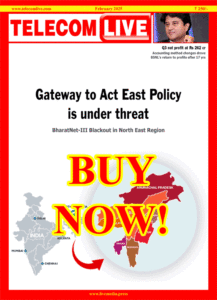BSNL, MTNL turn Ebidta positive, data rates fall to Rs 10.55 per unit: Government
Stressed state-run telcos Bharat Sanchar Nigam Limited (BSNL) and Mahanagar Telephone Nigam Limited (MTNL), have become earnings before interest, taxes, depreciation, and amortization (Ebidta) positive in the first-half of FY 2020-21, and the mobile data cost per Gigabyte (GB) has come down to as low as Rs 10.55, the Ministry of Communications (MoC) in a 2020 review said.
“The salary expenditure in BSNL and MTNL has reduced by around 50% (approx Rs. 600 crores per month) and 75% (approx Rs. 140 crores per month) respectively. EBITDA (Earnings before Interest, Taxes, Depreciation and Amortisation) have become positive in the first half of FY 2020-21 in both BSNL and MTNL,” the ministry said in a statement.
Last October, the Union Cabinet approved the revival package of Rs 69,000-crore for the two state-owned financially ailing telecom service providers that include voluntary retirement scheme (VRS), assets monetisation, and allocation of fourth-generation or 4G airwaves.
The government further said that the process for spectrum allocation for 4G services to BSNL on pan-India basis including Delhi and Mumbai has been initiated and funds have already been provisioned in FY 2020-21.
Last year, the VRS was taken by 92,956 employees of both telecom companies, and the Sovereign guarantee of Rs. 15,000-crore has been extended to BSNL.
In a yearly review, the ministry said that it has taken multiple reforms and decisions for the sectoral heath.
With wireless data usage being 75.21 Exabytes during the period of January to September 2020. The cost of data has also reduced substantially to Rs. 10.55 per GB, enabling affordable internet access for millions of citizens, it added.
India has the second-largest number of telephone connections in the world, and according to the government, the tele-density has reached 86.37%, while the rural tele-density is at 58.85%. As on October 30, 2020 the total telephone connections rose to 1171.72 million out of which 1151.73 million are mobile connections.
The Internet subscribers stood at 776.45 million with broadband connections reaching to 726.32 million in September 2020, the statistics revealed.
In a series of actions to facilitate digital connectivity in the country, Prime Minister Narendra Modi in August last year, launched optic-fiber cable (OFC) network connecting Andaman & Nicobar Islands to Chennai.
During the Independence Day address on August 15, Modi announced a 1000-day program to connect more than 6 lakh villages with fibre-based network, to deliver high-speed Internet servces.
Anshu Prakash-headed Department of Telecommunications (DoT), in an ambition to connect the uncovered areas of the North Eastern Region (NER), has undertaken the initiative to deploy 2,004 towers to cover 2,128 villages and National Highways.
The National democratic Alliance (NDA) government has also approved the provision of the Universal Service Obligation Fund (USOF) scheme for providing mobile connectivity in around 6000 villages of Arunachal Pradesh, Meghalaya and other parts of North Eastern states to bring these regions to the mainstream.
In December last year, the Cabinet approved setting up of Public Wi-Fi Networks by Public Data Office Aggregators (PDOAs) to provide public Wi-Fi service through Public Data Offices (PDOs) spread across the country to accelerate proliferation of Internet services.
Under the prestigious BharatNet program, nearly 1.50 lakh Gram Panchayats or village blocks have already been connected with high speed broadband connectivity, and by the end of December, close to 5 lakh Fiber-to-the-Home (FTTH) broadband connections have been provided.


